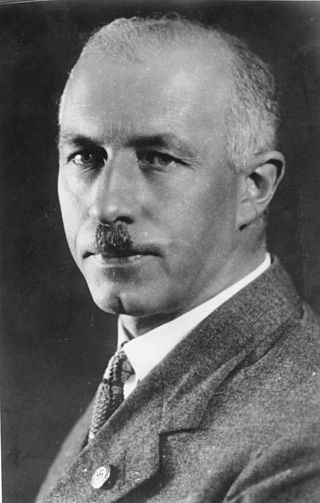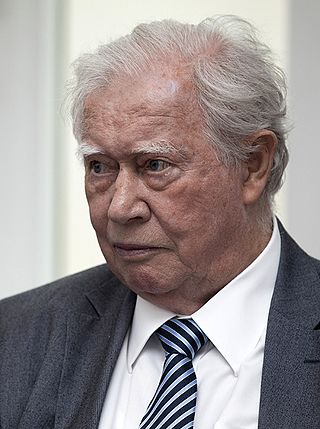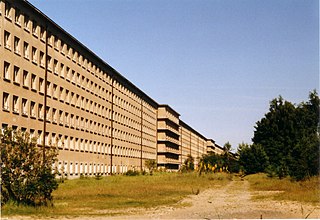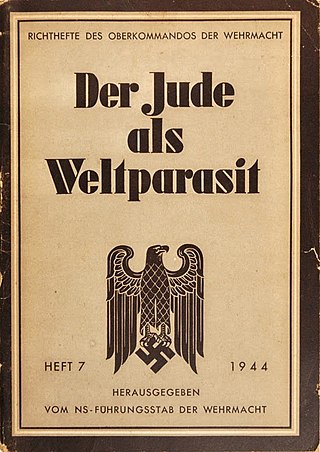
The Nazi Party, officially the National Socialist German Workers' Party, was a far-right political party in Germany active between 1920 and 1945 that created and supported the ideology of Nazism. Its precursor, the German Workers' Party, existed from 1919 to 1920. The Nazi Party emerged from the extremist German nationalist, racist and populist Freikorps paramilitary culture, which fought against communist uprisings in post–World War I Germany. The party was created to draw workers away from communism and into völkisch nationalism. Initially, Nazi political strategy focused on anti–big business, anti-bourgeois, and anti-capitalist rhetoric; it was later downplayed to gain the support of business leaders. By the 1930s, the party's main focus shifted to antisemitic and anti-Marxist themes. The party had little popular support until the Great Depression, when worsening living standards and widespread unemployment drove Germans into political extremism.

Fritz Todt was a German construction engineer and senior figure of the Nazi Party. He was the founder of Organisation Todt (OT), a military-engineering organisation that supplied German industry with forced labour, and served as Reich Minister for Armaments and Ammunition in Nazi Germany early in World War II, directing the entire German wartime military economy from that position.
Führer is a German word meaning "leader" or "guide". As a political title, it is strongly associated with Adolf Hitler, the dictator of Nazi Germany from 1933 to 1945. Hitler officially styled himself der Führer und Reichskanzler after the death of President Paul von Hindenburg in 1934 and the subsequent merging of the offices of Reichspräsident and Reichskanzler.

Gottfried Feder was a German civil engineer, a self-taught economist, and one of the early key members of the Nazi Party and its economic theoretician. It was one of his lectures, delivered in 1919, that drew Adolf Hitler into the party.
This is a list of words, terms, concepts and slogans of Nazi Germany used in the historiography covering the Nazi regime. Some words were coined by Adolf Hitler and other Nazi Party members. Other words and concepts were borrowed and appropriated, and other terms were already in use during the Weimar Republic. Finally, some are taken from Germany's cultural tradition.

Hans Mommsen was a German historian, known for his studies in German social history, for his functionalist interpretation of the Third Reich, and especially for arguing that Adolf Hitler was a weak dictator. Descended from Nobel Prizewinning historian Theodor Mommsen, he was a member of the Social Democratic Party of Germany.

Clemens Klotz was one of Adolf Hitler's architects.

Alfred Baeumler, was an Austrian-born German philosopher, pedagogue and prominent Nazi ideologue. From 1924 he taught at the Technische Universität Dresden, at first as an unsalaried lecturer Privatdozent. Bäumler was made associate professor (Extraordinarius) in 1928 and full professor (Ordinarius) a year later. From 1933 he taught philosophy and political education in Berlin as the director of the Institute for Political Pedagogy.
Franz Reinhold Schwede was a Nazi German politician, Oberbürgermeister of Coburg and both Gauleiter and Oberpräsident of Pomerania. An early supporter of Adolf Hitler in Coburg, Schwede used intimidation and propaganda to help elect the first Nazi-majority local government in Germany. This contributed to a personality cult surrounding Schwede and he became known as "Franz Schwede-Coburg." During World War II he ordered secret executions of the infirm and mass deportations of Jews. He also played a key role in abandoning the Pomeranian civilian population to the advancing Red Army, while escaping their fate himself. In 1945 he was captured by the British Army and in 1948 he was tried and convicted of war crimes.
Emanuel Hirsch was a German Protestant theologian and also a member of the Nazi Party and the Nazi supporting body. He escaped denazification at the end of the war by quitting his professorship, allegedly for health reasons, losing the pension from his University.

National Political Institutes of Education were secondary boarding schools in Nazi Germany. They were founded as ‘community education sites’ after the Nazi seizure of power in 1933.
The National Socialist German Students' Union was founded in 1926 as a division of the Nazi Party with the mission of integrating University-level education and academic life within the framework of the Nazi worldview. Organized strictly in accord with the Führerprinzip as well as the principle of Machtdistanz, the NSDStB housed its members in so-called Kameradschaftshäusern, and had its members decked out in classic brown shirts and its own distinctive Swastika emblems.

Ordensburg Vogelsang is a former Nazi complex located within the former military training area of Vogelsang in the Eifel National Park in North Rhine-Westphalia.

Anti-Jewish legislation in pre-war Nazi Germany comprised several laws that segregated the Jews from German society and restricted Jewish people's political, legal and civil rights. Major legislative initiatives included a series of restrictive laws passed in 1933, the Nuremberg Laws of 1935, and a final wave of legislation preceding Germany's entry into World War II.
Erich Kern, was a far-right Austrian journalist, war-time propagandist, and a post-war Nazi activist. He became a writer of revisionist books that sought to glorify the activities of the German soldiers during the Second World War.
In Nazi Germany, the NS-Ordensburgen, also called Schulungsburgen, were schools developed for elite Nazi military echelons. There were strict requirements for admission to the schools. Junker candidates had to be aged between 25 and 30 years old, belong to either the Nazi Party, the Hitler Youth, the Sturmabteilung, or the Schutzstaffel, be physically completely healthy, and be pure-blooded with no hereditary defects. The term Ordensburg was borrowed by the Nazis from the historic Teutonic Order, which had built numerous Order Castles (Ordensburgen) during the medieval period.

Nazi architecture is the architecture promoted by Adolf Hitler and the Nazi regime from 1933 until its fall in 1945, connected with urban planning in Nazi Germany. It is characterized by three forms: a stripped neoclassicism, typified by the designs of Albert Speer; a vernacular style that drew inspiration from traditional rural architecture, especially alpine; and a utilitarian style followed for major infrastructure projects and industrial or military complexes. Nazi ideology took a pluralist attitude to architecture; however, Hitler himself believed that form follows function and wrote against "stupid imitations of the past".

Nationalsozialistische Führungsoffiziere were officers of the German Wehrmacht in World War II tasked with teaching Nazi ideology to soldiers. It was regarded as important that some officers should have the responsibility of both military command and political instruction in the spirit of Nazism. In this respect, NSFO were different from political commissars of the Red Army, who did not have military command.










